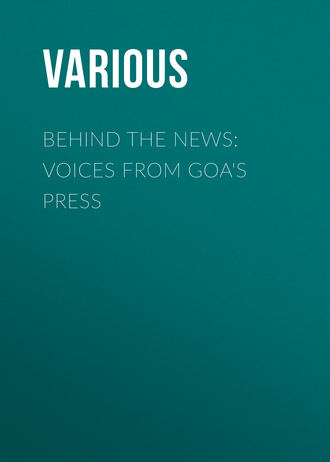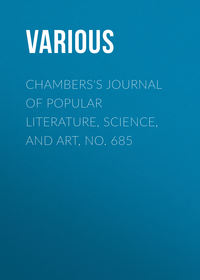 полная версия
полная версияПолная версия
Behind the News: Voices from Goa's Press
With complete censorship, voluntary or otherwise, Goan journalists seem to exist in a blissful state of non-competitiveness. Trained to break stories and score one on the competition, I was amazed at the unofficial news pool system that operates at the Press Room at the Panjim Secretariat. The twice-daily 'edit meets' at the Adil Shahi palace ensures that only the very junior reporters intimidated by the Press Room circle break stories of any importance. One could depend on the juniors at The Herald and Gomantak Times (under Ashwin Tombat ) to put out at least one readable story a day.
Understandably, Goa's newspapers survive on a staple of political verbiage all generated from the safe confines of the Press Room. Unverified allegations that would not pass muster with even a trainee in a national newspaper find play on the front pages. With no facility to train journalists in the state, trainees here look towards the Press Room as some kind of a finishing school!
Over the years, the Press Room crowd have attached themselves to the camps of different politicians. It's a temptation common to journalists in every small town and Goan journalists have fallen neck deep in it. With nothing exciting enough, politics becomes the all-consuming passion for 'senior journalists'. So the current storm over journalists accused of obtaining favours from the current BJP-run dispensation comes as no surprise.
It has always been easy for journalists to be sucked into different political camps considering the proliferation of politicians in the state. There are 40 MLAs, three MPs – including one in the Rajya Sabha – and scores of municipal/panchayat level 'leaders' for a population of less than 1.4 million which includes the Gulfies and shippies).
Even junior reporters easily manage to invite a minister or two for family functions. Journalists are also not above seeking the help of politicians to solve problems even in their workplaces. Many of them even grow to depend on the ruling politicians for basics like accommodation in the capital because of inadequate remuneration from their employers.
It's the same story everywhere in the country, but the sheer number of journalists in a big city like Mumbai or Delhi helps mask the dilution of ethics among a select few. Like everywhere else in the world a few journalists in Goa too happily combine their jobs and elective roles as fixers for politicians. The icing on the cake is however to inveigle into a chief minister's coterie thereby ensuring government contracts for self or family members.
Under the chief ministership of Manohar Parrikar, the issue has hit the headlines especially after Rajan Narayan announced his resignation from the Herald (in September 2003). But during his days in the opposition, Parrikar slogged at wooing the media. As leader of the Opposition, Parrikar could be depended upon to come up with all sorts of files to put the then Congress government on the mat. Journalists looking for a juicy story never returned disappointed. To be fair to Parrikar he did not even hint about the need for a quid pro quo from the journalists tapping him for information on the then Congress government.
Journalists who are now accused of obtaining favours from the incumbent chief minister were even then known to be part of Parrikar's coterie, though a large number of journalists sought out the former leader of the opposition. However with the media eating out of his hands, Parrikar had the mantle of Mr Clean wrapped on his shoulders – either by design or by default. One now gets the feeling that a small group of journalists probably played a part in building Parrikar's reputation with the expectations of being paid back at an appropriate time. Agreed, there is genuine admiration for the man – IIT Bombay alumni, quick acting, with a vision for the middle class, etc. But the cause of good journalism is compromised.
Today, there is very little criticism coming up against the ruling BJP government in Goan newspapers. For instance, there has been very muted coverage of some elements in Parrikar's cabinet – like a minister who is rumoured to be pushing illegals into Europe. Another worthy has a reputation of being a ruthless moneylender whose rumored 'sex scandals' could even put Jalgaon to shame, as the BJP leadership is itself known to have once argued.
The kid-glove treatment meted out to the BJP government has also been extended to the extend Sangh parivar, despite the ideological opposition to it in many sections of the Goan society. Parrikar's handing over government schools to unregistered groups of alleged RSS-linked activists barely registers a presence in local discourse even among members of the minority Christian community traditionally opposed to right-wing Hindu politics.
While the reluctance of local newspapers to rattle the ruling politicians is understandable, there is really no reason for correspondents of outstation newspapers to follow suit. But for a couple of honorable exceptions, correspondents with outstation publications too have decided to toe the government line. Unfortunately for Goa, the market is too small to attract the attention of any national or international investor in the media scene.
Most of the quarter-million or so households in Goa who can afford to do so, already buy a newspaper and a new investor can only hope to net a marginal increase in circulation. The failure of The Times of India to penetrate the Goan market is a case in point. With its financial muscle, the Times was best placed to shake up the Goan market. Even while skirting controversial issues, the newspaper could have made an impact with a comprehensive coverage of Goa. But the newspaper clearly did not see it worthwhile to continue and pulled out after a four-year long presence, and 'Goa edition' plans, in the state.
Even the Sakal group, the other outside group to enter Goa, has not been able to figure out the English-language newspaper market here. Having bought over the Gomantak from the Chowgules, the Sakal group does not seem to be interested in making big-ticket investments in the English-language Gomantak Times. As Goa's third English-language daily continues to bleed, there is a very strong possibility that there would be one less player in the English language market in the near future.
One can only hope that increased competition following the entry of foreign publications in India provides enough incentives for future players to dig their heels deeper into the Goan market. Hopefully, national players in the media business and expatriate Goans will see a market in selling quality journalism in Goa.
Chapter 16: An accidental Bhailo
Rahul GoswamiRahul Goswami, one of Goa's most hardworking and innovative outstation correspondent, covered this state for the Business Standard, in the mid-nineties. He is today based in Singapore. On a lighter note, RG says he was offered, several times during his stint in Goa, bribes by various colleagues envious of his posting as inducement to trade places with them. Instead, he went to Bombay to quarrel with newspaper vendors, went to the Gulf to start up a dot-bomb, went to Singapore to learn Mandarin, and is now wondering if those bribes are still on offer.
Arriving to live and work in 'aparanta' – a place beyond the end, as the Sanskrit texts would have us believe, where time stands still – was always going to be a challenge for the conscientious newspaper correspondent. Even when one does not do so blind, as I comforted myself in 1993.
It was Goa Dourada, Golden Goa, Perola do Oriente, Pearl of the East, Roma do Oriente, and other such colourfulness that I was being assigned to. The imagery was breath-taking – corsairs, corruption and conversions. There were heart-warming tales of gruff compassion – whether from the dashing Marathas or their debonair Portuguese rivals. There were edgy accounts of the rivalries of contentious nationalisms, delicious stories of grand thievery, fabulous stories of immoral profligacy, of debauched viceroys who equalled in pomp and splendour the Asian potentates they dealt with.
This was, I thought to myself, the stuff of a hundred feature stories, the mother-lode of post-colonial memorabilia, the gateway to phantasmagorical explorations. Indeed they were, but in no way that I had imagined at the outset, overcome then by the cultural fecundity of 'aparanta'. Imaging Goa, as a curious ingenue, as a journalist, as an informed participant, has never been an easy task and indeed is one that has grown more onerous over the years.
Indeed the provenance of such a view is a curious one, and yet one that is well-known. The widespread tendency in Western writing of India – and, by extension, of Goa – has been to condense the description of the scenic beauty and natural resourcefulness, the cosmopolitan life and the imagined mercantile prosperity of the early colonial period, into pastel-coloured, palatable images. So it is too with Goa Dourada, or Golden Goa.
The Goa that has been perpetuated in the newsrooms of the media conglomerates of urban India – an English construction, I would like to emphasise – has even now more in common with the hazy feel-good miasma that occulted the communal perceptions of the dharma bum generation that made its way from the West, in a slow and tortuous ganja-laden, booze-sodden crawl, through the tolerant places of the 'Third World'. The difference was, and is, that the dharma bums smoked and drank and blissfully fornicated under the moonlight that bathed the silvery beaches of 'aparanta' and dreamt of equality and human emancipation (to be fair to many of them).
The news editors and feature editors and editors-in-chief and numberless marketing imbeciles who chose to imagine Goa, within the narrow and noisome worlds that defined their own existences in the megapolis of their choosing, had on the other hand no such overarching humaneness, despite generous applications of all that is narcotic and alcoholic. 'Aparanta', I found, may welcome all comers, but it also encourages those processes that sift out the unbelievers.
How, I asked myself, is one to distinguish? What is the Goan-ness that one is seeking to understand and, if possible, to give substance to in a 1,200-word report (under the illiterate regimes that run newsrooms these days, that is a torrent of words)? Can one encapsulate all that seeks to be distilled by this multitude of experiences, of personal encounters, by listening to the narratives of the histories of Goa? And when one does become an ideological sympathiser of the dharma that is 'aparanta', how can one convey it to the hard-eyed stewards who rule over the column centimetres in Bombay or Delhi?
It was a question that had no simple answer. My own method was to attempt to blend in with the rhythms of the village in which I lived, Betim, which lies across the river Mandovi, opposite Panaji. The river is like a slow-moving artery that expresses Goa – the rusting, elderly ferries of the River Navigation Department chug across the gap with a ponderous regularity, and in doing so determine the schedules of legions of Goans who live within a short bus ride of the water – 'aparanta' tends not to respect time-pieces worn on one's wrist.
In this I was marginally successful. Mahadeo was one of my neighbours – a generously-bellied Betim elder who with surprising agility climbed into his canoe and laid his meagre nets along the river shallows. Mahadeo was also adept at catching river crabs, and when one morning I found a pair – neatly trussed and no more than two hours old – squirming outside my front door I realised with a thrill that I was accepted by the Betim-kars.
Mahadeo – despite his belly a very handsome man with a tanned visage crowned by a mop of white curls, with a commanding presence and possessing an enviable facility with a little skiff barely a foot across – was only one of a series of revelations. There were the nearby family Bhosale, whom I had been warned "were trouble", the "rowdy boys" of the village who tended to be destructive, the crooked 'possorkars' from whom I would be forced to purchase my groceries. The roll-call of potential villains was long indeed.
All unfounded. The rhythms of 'aparanta', as they found this 'bhailo' in Betim, ensured harmony. My dilemma was, how might I convey this to urban-bred news editors who have little tolerance for a mofussil correspondent's rural romanticism, as they saw it? Sometimes, fortune intervenes. In my case, while reporting for Business Standard, it came in the form of C P Kuruvilla, to my mind the most super-aware news editor of the last two decades.
Kuru, as we called him, was (he has voluntarily withdrawn from the circus that is print media, hence 'was') a maverick before the term found fashion, and was so within the relatively severe environs of the Ananda Bazar Patrika. Kuru provided the intellectual get-up-and-go that impelled a legion of correspondents to hit the road in search of stories that were to become memorable ones, and even more remarkable, was able to do so in the context of a mainstream business newspaper.
Will you find a Kuru nowadays? No, is the likely answer. Editors, sad to say, tend to be almost uniformly useless. It is left to the greater community of journalists to provide the context, the space, the encouragement, and the means. The encouragement, context and professional support has perforce now to come from within. This working alternative has not only become desirable, it has become imperative for for the non-sarkari journalists.
The problem is a systemic one today; there should have been manuals passed on, but system administrators have deleted them. Where binaries perish, we must turn to mnemonics. There was a time when some of us in The Sunday Observer successfully ran a tactical media counter-insurgency within the framework.
An immediate provocation at the time was a faux editorial regime presided over by an imposter named Pritish Nandy. Every Friday (dak edition) and every Saturday (city edition) we would have to redefine and re-take our territory and remind the insurgents that they had no place in it. It was hard work – outright threats and go-slows, files full of protest notes and minutes of meetings, and the halting evolution of a code that cut across the barriers that traditionally define a functioning news organism. I think it worked well at the time – the guerrillas who did this are still here.
Our questions were basic – why can sanitation not be "sold"? Why can education not be? Labour not be? Health not be? The elderly not be? That this not only assumes but reflects the dreadful significance of "sold" indicates why we still need guerrillas in the newsroom. These guerrillas, if they still exist and can still be drafted, will come up against some formidable mantras. "All things are more or less of equal import: all are only daily" is one. If you ask one of the system administrators she will reply: "All data are equal, but some are more equal than others."
That is why, we are reminded by those who give the system administrators their wages, the media have produced their own heroines and myths, which can compete with the traditional ones and moreover happily embroider over them. I was once advised that "journalism asks us to invest in the stock-market of momentary sensation". After such sexualist reduction, what forgiveness?
The difficulty lies in the accepted impermanence of our art, our skill, and the relentless transformation of today's news feature into tomorrow's newsprint into the day after tomorrow's wrapping paper for pakodas. The media that we construct (from the point of view of the consumer, and the brokers who interpose themselves between writer and audience) offers titillating speculations on danger, scandal, death, nightmare, opportunity.
Like a television talk-show host tripping loquaciously on industrial-strength amphetamines, it rattles noisily on, uncaring of the quiet interjections about sanitation, infant mortality, unreported police atrocities, tribal communities flooded out of their homes. And that is so both in an India that has reclaimed 'aparanta' without caring to know the topography of Goa, as it is in the desolate urban scapes that seek to define the middle classes who – reliable sources say – are the new India that seeks to spend.
The rules of the game have changed and we do need a new set of guerrillas. Newsroom disobedience is not what it used to be (is it at all what it was?). Who is willing to explore the new paradigm? It is so easy to stay in the bunker of assurances. No conclusions, no certainty; only performance analyses, management matrices, and practical wagers. We really do need a bunch of newsroom narkasurs here.
Can one seek for and hope for such a dimension in Goa? Will 'aparanta' provide it? Not readily. Early in my apprenticeship as a correspondent in Goa I ran into the local brand of sarkari thought. It was one of those endless afternoons in the old press room, the one in the corner of the Idalcao. A minion from one of the chambers above clattered in through the swing doors and muttered something. He was half asleep and so were the occupants of the press room, those who were not wrestling with the typewriters.
We all streamed out, following the minion. Through the wooden security gate we filed, the one that is supposed to detect the presence of suspicious metal objects on one's person, and up the stairs we climbed. Across a landing whose timbers had been scuffed shiny by the passage of tired footwear, then down a verandah over which hung tattered pieces of plastic in an ugly and half-hearted attempt to keep out the rain. And finally into some functionary's room.
It turned out to be occupied by some minister, who lolled indulgently behind a desk. He was Luizinho Faleiro, before he became a big wheel, but who was even at the time odious. We chose seats. Greasy khitmutgars passed amongst us, proferring cups of tea and soggy biscuits. Luizinho grinned a sepulchral grin, as if privately awaiting the demise of one or another of those who had just seated themselves. Then, as if disappointed by the absence of such drama, he coughed and began.
"I have called you here," he announced brusquely, "to comment on…" and there followed some dull government programme or the other. Luizinho, with another graveyard grin, then collected his belly, cleared his throat and barked: "Take down!". And then proceeded to provide what I can only call dictation. To the credit of about a third of his audience, they did not whip out a notebook to scribble. The rest, shamefully, played the part of stenographers. It was my first encounter with the Establishment's view of the Press, and of the willingness of that part of the state's press to permit such a relationship.
Luizinho was merely following tradition, just as surely as the passage of the full barges bearing iron ore, which announced themselves with a dull throb as the red mineral made its way to the mouth of the Zuari and the hungry ore carriers berthed there. For they were – and are – one and the same. Government functionary and river vessel – both vehicles of the powers that seek to control 'aparanta'. Does it work? Should it?
It does in fact work. Teotonio de Souza, before he departed from the Xavier Centre of Historical Research, had chatted with me on a few occasions. He had been, then, as critical of the Church as he was of the gradual change he saw in Goa's politics and middle-class political consciousness. He had told me, up there in the haze of one Porvorim afternoon, how he had been amused to read that "Goans are largely a T-shirt wearing population".
That comment came from one Arun Sinha, who was then, and as far as I know continues to be, editor of The Navhind Times. Teotonio seemed at first mildly intrigued by this person's interpretation of the Goanness of Goans. But then the historian also revealed a resigned bitterness about what else he perceived in the journalist's prose. "One wonders," he wrote later, "if to be wholly Indian one has to chew 'paan' and spit it all around, or replace T-shirts or G-shorts with kurta-pajama or safari suit."
It is part of a misguided mission which propagates itself apparently tirelessly and without mercy – that there are caricatures which continue to be attributed to Goans. Very often, they are invented by bureaucrats and self-styled "professionals" who want to teach Goans to be less easy-going or less un-Indian. I suspect that one Manohar Parrikar, the current Big Wheel in the circus that is Goa's government of the day, is just as keen to socially re-engineer the Goan masses. Nor is he the first, nor most zealous of those who have wished to do so.
The trouble for the correspondent in Goa – zealous or cantankerous or otherwise – is that one never seems to escape the impression that, in a certain way, de-colonisation has not yet been digested. It is not that the departure of the Portuguese is regretted (there are exceptions, of course) but the question of why, Portuguese colonisation remains so strenuously berated. How is one to internalise this truth, seek to convey to our readers the paradoxes that abound in our reading of this beautiful, bewitching 'aparanta'? How can one negotiate for oneself the editorial space to do so?
I do not mean this to be a disheartening preface for the hapless correspondent who finds herself deposited in Goa, without the benefit of an immediate acquaintance with Peter's (St Inez), Joao's (opposite the now notorious Hotel Neptune), or Martin's (whose staff has long since relapsed into slumber). Given the dismal state of the print media in India today, the days of the full-time state correspondent seem to be distant memories (my friend and comrade Prakash Kamat has on the other hand proven to be remarkably resilient!).
The simple truth is that the "Goan culture" that is so venally peddled aboard the tourist boats that shamelessly and noisily ply the Mandovi off Panaji (how I wish they would cease) is far from easily definable. Cultures never do remain isolated or static, and certainly not the seaborne cultures of which Goa, Govapuri, Gopakapatnam, became a part.
And it is indeed true that the mechanism which supported the 'Estado de India' nourished a very unique place, one which internalised the life-affirming concept behind a word redolent of the very essence of Goan-ness, a word that resounds with wisdom – sussegado.
Chapter 17: Why Konkani failed its readers…
Raju Nayak, one of the home-grown products in journalism that Goa can take pride in, has worked on the newsdesks of mainstream Marathi newspapers in the media-capital of Mumbai, has edited the Sunaparant in a tumultous period (as this essays shows) and today tells the story through the Indian Express to the ire of politicians who would like a more flattering image to be put out. Together with Devika Sequeira, he is behind the recently launched and yet-unnamed forum that meets monthly to discuss issues of relevance and concern to the media profession.
If I am told to evaluate Marathi and Konkani journalism in Goa, I would surely rank the Marathi media ahead of its Konkani counterparts.
Despite of it being accused of creating a rift between Hindu and Catholic masses over the issue of Goa's merger with Maharashtra in the 1960s and 1970s, the Marathi press has managed better to maintain the standards of journalism. The Marathi media in Goa has all along borne the torch of social activism, by backing the cause of the 'bahujan samaj' or the backward communities, and also fought hard to expose corruption in Goa's polity.
In comparison, the Konkani press hopelessly failed to live up to people's expectations. The only Konkani daily, Sunaparant failed to instill journalistic values in the Konkani media. The newspaper, which was originally set up to promote Konkani, never became a complete newspaper in its own right. Rather it has become, in recent years, a platform for sections of the Konkani language activists in Goa. The Konkani press in general abjured professionalism in order to cosy up with the political party in power.
On the other hand, the Marathi press was infused with a new vitality following the launching of several new publications at regular intervals. Gomantak, Tarun Bharat, Navaprabha and Rashtramat have been product of Marathi journalism flourishing in this Konkani-dominated state.
A glance at the circulation figures of these dailies unearth the story behind the real tastes of Goan readers. It is estimated that Marathi newspapers collectively sell more than 50,000 copies per day. In comparison, the sole Konkani daily sells less than 500 copies per day.











